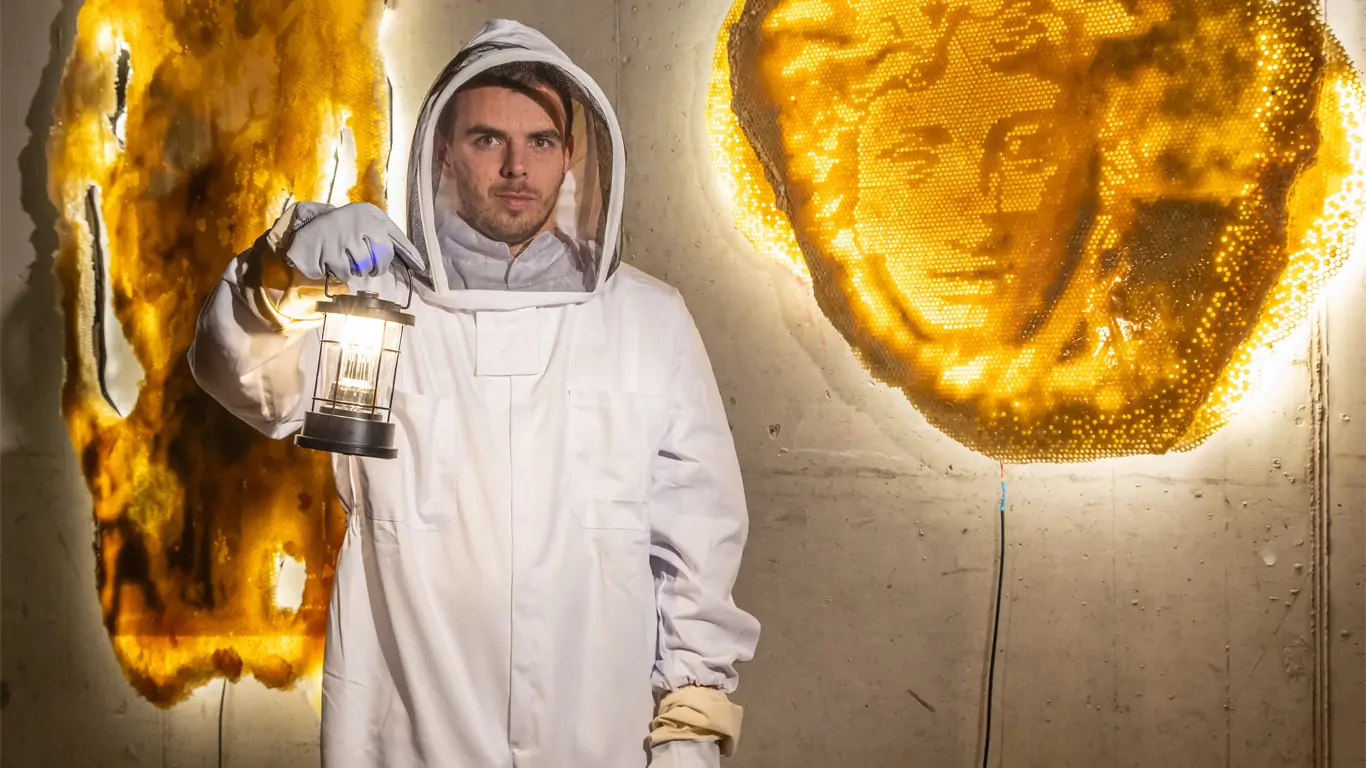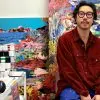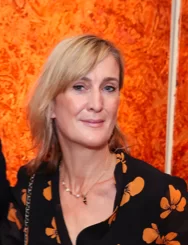I had a conversation with ‘Nature the Artist,’ AKA Tomás João, about his inaugural UK solo exhibition, ‘The Colony,’ and his artist residency at Gasholders. Lisbon-born artist Tomás João, who goes by the Moniker of ‘Nature the Artist’, presents ‘The Colony’ at Gasworks in Kings Cross. ‘The Colony’ is themed around a mysterious species of bee which was discovered in London a few years ago, and visitors to the immersive exhibition can expect to navigate a darkened room illuminated by lantern-light, exploring bee-like structures created by the artist as a comment on how human behaviour impacts the natural world.
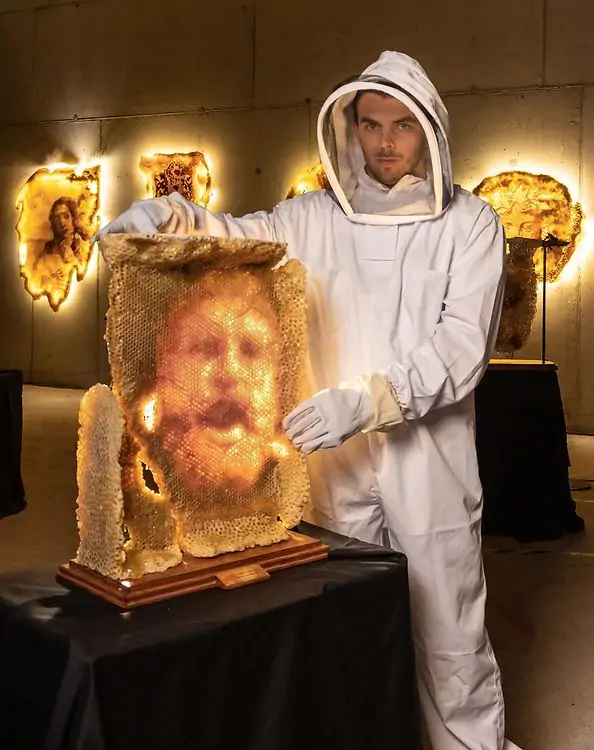
Credit John Sturrock
The fragility of the structures on display in The Colony acts as a metaphor for the fragility of our ecosystem. The exhibition is part of the King’s Cross art programme of indoor and outdoor art exhibitions.
Lee Sharrock: Your exhibition The Colony in Kings Cross is inspired by a mysterious species of bees that were discovered living underground in London several years ago. How did you hear about this Bee colony and who invited you to exhibit at Gasholders?
Nature the Artist: My practice has always been inspired by the crossovers and contentions between nature and humanity. I wanted to unravel a narrative as with all my work, based on related occurrences in the natural and urban capitalist worlds. I grew up watching the Bees in my Grandmother’s farm, and was always fascinated by their industriousness. The way they made their way through nature happily, but with this higher sense of purpose. I began borrowing from the structural elements of their community, their visual language, and using it as a way to convey wider discussions going on in my practice. This was the starting point of the show.
Given King’s Cross ongoing focus on the environment and community, they had heard of my work in Lisbon, and I was honoured to be invited to take part in this residency. This area is an example of where there is a bit of harmony. There’s a respect for nature, the gardens and the wildlife along the canal, but it’s been brought together in this way with the neighbourhood’s industrial past through architecture and design.

Credit John Sturrock
Lee Sharrock: Visitors to the exhibition will be invited to explore the Gasholders exhibition space in the dark with the only light source coming from Lanterns. Would you describe this an immersive exhibition, and what can visitors expect?
Nature the Artist: Definitely. It’s a journey in exploration and discovery for each visitor. If someone visits one of my exhibitions and leaves laughing, crying or even perplexed, that makes my day. I think art should be appreciated, enjoyed or interpreted in whatever way people want to – that’s the joy of it. My hope is to create curiosity, humour, and provoke a wider reflection on the world and the effect our actions have on it.
Lee Sharrock: Why did you decide to go by the Moniker of “Nature the Artist”?
Nature the Artist: Initially I started out with the name Forest Dump, but over time adopted Nature The Artist as a reference to elements of the natural world that have always inspired my practice. In theory, nature is a constant, something that exists irresepective to us. Our continued actions have irreparable impacts, disrupting every natural process. I always want to step back and make nature the protagonist, to give it its voice back, to allow its point of view to be the priority.

Credit John Sturrock
Lee Sharrock: We are on the brink of the 6th mass extinction, with world temperature accelerating at an unprecedented rate, and the planet is experiencing the devastating effects of global warming. What role do bees play in maintaining biodiversity and what attracted you to the study of bee colonies as part of your artistic practice?
Nature the Artist: Bees are the basis of life; we need them to be able to sustain ourselves. In The Colony we discover how these Bees are the artists, one of many in the natural world, and we want to invite wider discussion about the things in society to which we assign value. Art serves as a powerful mode of communication, essential for addressing and resolving societal issues. It possesses the unique ability to articulate complex concepts through the language of emotions, which I believe is a profoundly impactful form of expression.
However, I contend that the influence of art extends beyond mere problem exposition. It possesses the extraordinary potential to unify people, fostering collaboration and facilitating problem-solving efforts. Throughout history that has been the only way major problems were solved.
In initial conversations with visitors to the Kings Cross exhibition, we’ve noticed a heightened awareness in the UK about how integral Bees are for the earth and humanity. We wanted to frame the exhibition with actual insights on this topic, and we were fortunate enough to open the exhibition with a talk by Dr. Lars Chittka, professor of Sensory and Behavioural Ecology (QML) and author of ‘Introduction to the Mind of a Bee’.
Lee Sharrock: Your career as an artist began in 2016 and your practice includes painting, photography, video and street installations. Did you study at art school or art you self taught?
Nature the Artist: Yes, I studied Fine Arts in Leiria, but the desire to make art came much earlier from the simple joy of sketching on desks in school as a kid. I especially remember one very beautiful thing at the time, which was that there was no pressure in relation to that image staying forever. Over time, these sketches evolved into graffiti, which I did for quite a few years, but I was always interested in exploring themes around science and biology, painting, building and creating with natural elements to provide an ‘immersive’ and ‘confrontational’ experience.
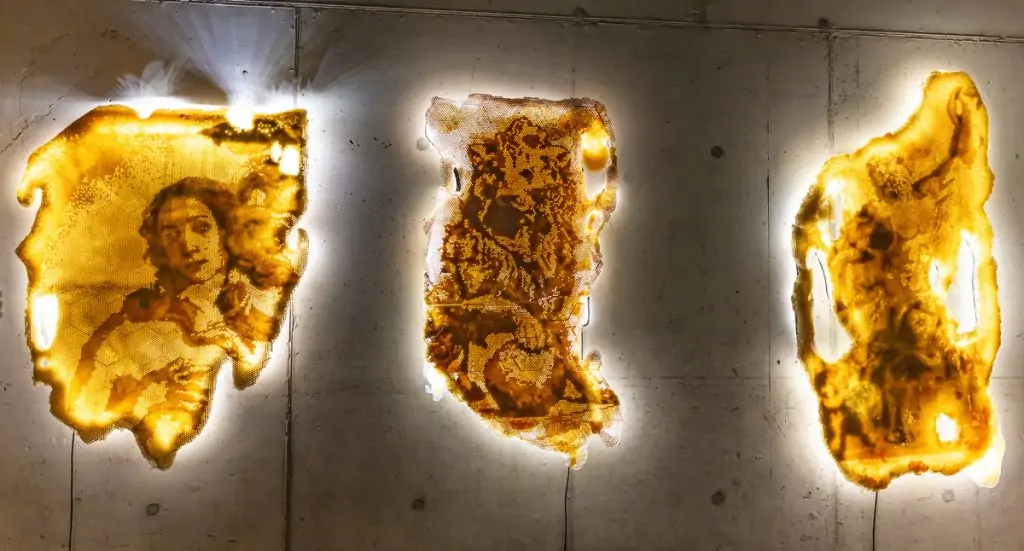
Credit John Sturrock
I was raised by the beach, engaging in activities like surfing, snorkelling, camping and fishing. These experiences granted me ample time in natural environments. Being immersed in nature evokes a distinct feeling; amidst such surroundings, human constructs like laws and beliefs seem fictitious. On good days, this perspective allows me to contemplate human society from an outsider’s viewpoint. This, I believe, forms the foundation of all my work.
Lee Sharrock: This is your first exhibition in London. Do you have plans for exhibitions in other cities?
Nature the Artist: Yes, for sure, and we’ve been really overwhelmed with the reception we have received so far and enquiries to where they’re going to see us next. Keep an eye out!
The Colony is at Gasholders until 21st April, 2024: https://www.kingscross.co.uk/event/the-colony
©2024 Nature the Artist


